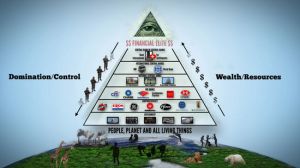Before I go on to begin posts on what I call my LEAF formula, I wanted to take the time and explain my theoretical view on how the world should be working from the perspective of what I feel are the major problems affecting it. I’ve made mention, in a few posts, of what I call top down dominance hierarchy control structures. These structures are what I consider to be at the root of many problems we encounter; and by WE I mean our industrialized Carbon Clan. For more detail, let me break it down as follows…
What are the problems?
It’s hard to deny that for decades now, the United States and many of the developed and industrialized nations of the world, that I have referred to as our Carbon Clan, have been in a steady state of decline. This decline can be measured in a variety of ways from physical health to mental health, educational decline, economic depressions, the diminishing personal happiness of large populations, worsening environmental conditions and other factors. During this same period, a corresponding increase in war, famine, disease and most importantly, the disparaging imbalance of wealth distribution throughout the world, has been witnessed. In addition to the Carbon Clan’s decent into a depression is the realization of extreme ecological crimes being perpetrated on people and the planet as a whole. The stark facts of our planet’s and nations’ dire situation have not gone unnoticed and by all accounts, a global awakening is already happening. A worldwide awareness of these problems is manifesting into networks of singularly minded individuals who seek to teach, grow, clean, care and most importantly, to thrive in the face of this adversity.
How did we get here?
Qui Bono: Who benefits?
Volumes of literature and months of debate can be wasted on the discussion of wether there are people who stand to gain from all of what has been proposed so far. In the interest of brevity, it is assumed that if you are engaged in this blog, that you have some opinion that aligns with the thought that there is in fact a supra-national class of entities that transcend borders and do in fact have a great deal to gain by enslaving as much of the human race in debt and poverty as possible. And if not, then by at least treating many of these problems as if there were a global dominance agenda out to control the world, we might better embark on solutions.
What are the solutions?
Very simply, take the power back! Many of the solutions suggested here center on principals of liberty, self-reliance, voluntary cooperation, sound monetary principles and open source development of key technologies. [Take time to check out these links] None of these solutions are radical nor are they cutting edge. In fact, many if not all of them stem from taking steps back to earlier models that worked well, but were changed radically over time to favor centralized dominance. If the world is to find it’s way out of it’s current situation, it will take many solutions being acted upon by a multitude of individuals with vision. The goal should be to put as many tools as possible in the hands of willing participants, who wish to take on some of these challenges directly, rather than waiting for solutions from the governments or big corporations.
Why are the principals of liberty so important?
“The natural progress of things is for liberty to yield, and government to gain ground.” ~Thomas Jefferson
Jefferson knew the dangers of yielding Liberty. His warning then, lost in history, proved prophetic as more and more people and nations have relinquished their liberties to not just bigger governments, but to other forms of control such as consumerism and corporations. Today’s geopolitical, multinational, consumer lifestyle is not so much directed by people through nations and laws, so much as it is completely mechanized by corporations and markets. The people have become “Subjects” once again only under a more euphemistically acceptable term known as “Consumer.” Today, much of what the “Consumer” actually NEEDS for survival, does not have to come from the corporate model. In fact, todays technology and systems actually make “Self-reliance” models much more beneficial in some key industries. With the right methods and support, many of these key industries may be regained by the consumer in a sort of “New Declaration of Self-reliance,” whereby Jefferson’s quote from above might be reversed to say:
“The natural progress of things is for liberty to gain ground, and for government and corporations to yield.”
Why self-reliance?
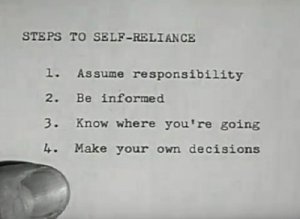 Self-reliance means to be reliant on one’s own capabilities, judgment, or resources; independence. The capability for self-reliance has become greater as improvements in technology and processes have improved, yet many people have become evermore dependent on systems of centralized control. Examples of this control can be seen in the areas of food production, news and information, energy, healthcare, education, and especially economics. In a multitude of ways, much of this centralization of control does not actually benefit those who are dependent on it for their survival. By exposing the fallacy of this dependance, and supporting models of self-reliance, many people will become empowered to support themselves and those around them. Because “no man is an island,” the self- reliance model is best supported by Voluntary Cooperation. Voluntary cooperation allows for several individuals to come together for a specified purpose and work with many people for services that are needed or wanted. This voluntary cooperation works much the same way a government or corporation does with the exception being that the coop is owned and in many cases operated by it’s members. The business is actually controlled by the very people who rely on it for the services it provides. Now imagine if people were empowered to come together to voluntarily participate in the very systems they have become dependent on. Imagine if enterprising individuals cooperatively developed businesses in self-reliance that focused on the areas of food production, news and information, energy, healthcare, education, and economics. One astounding fact is that cooperatives already exist in all of these areas and more. Self-reliance embodies this idea of voluntary cooperation whereby many people can come together to build the very systems necessary to resist the ever-growing dependency on centralized, corporate and government controlled dominance.
Self-reliance means to be reliant on one’s own capabilities, judgment, or resources; independence. The capability for self-reliance has become greater as improvements in technology and processes have improved, yet many people have become evermore dependent on systems of centralized control. Examples of this control can be seen in the areas of food production, news and information, energy, healthcare, education, and especially economics. In a multitude of ways, much of this centralization of control does not actually benefit those who are dependent on it for their survival. By exposing the fallacy of this dependance, and supporting models of self-reliance, many people will become empowered to support themselves and those around them. Because “no man is an island,” the self- reliance model is best supported by Voluntary Cooperation. Voluntary cooperation allows for several individuals to come together for a specified purpose and work with many people for services that are needed or wanted. This voluntary cooperation works much the same way a government or corporation does with the exception being that the coop is owned and in many cases operated by it’s members. The business is actually controlled by the very people who rely on it for the services it provides. Now imagine if people were empowered to come together to voluntarily participate in the very systems they have become dependent on. Imagine if enterprising individuals cooperatively developed businesses in self-reliance that focused on the areas of food production, news and information, energy, healthcare, education, and economics. One astounding fact is that cooperatives already exist in all of these areas and more. Self-reliance embodies this idea of voluntary cooperation whereby many people can come together to build the very systems necessary to resist the ever-growing dependency on centralized, corporate and government controlled dominance.
What do you mean by voluntary cooperation?
Voluntary Cooperation can best be seen to work in cooperative businesses.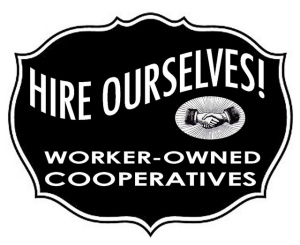 Cooperatives are nothing new and their principles date back to a far back as human beings have been organizing for mutual benefit. Besides being an autonomous association of persons who voluntarily cooperate for their mutual, social, economic, and cultural benefit, coops have the distinction of being a more stable and reliable business model than their corporate counterparts. According to the book Capital and the Debt Trap: Learning from Cooperatives in the Global Crisis:
Cooperatives are nothing new and their principles date back to a far back as human beings have been organizing for mutual benefit. Besides being an autonomous association of persons who voluntarily cooperate for their mutual, social, economic, and cultural benefit, coops have the distinction of being a more stable and reliable business model than their corporate counterparts. According to the book Capital and the Debt Trap: Learning from Cooperatives in the Global Crisis:
“Cooperatives tend to have a longer life than other types of enterprise, and thus a higher level of entrepreneurial sustainability. In one study, the rate of survival of cooperatives after three years was 75 percent, whereas it was only 48 percent for all enterprises, and after ten years, 44 percent of cooperatives were still in operation, whereas the ratio was only 20 percent for all enterprises. Cooperative banks build up counter-cyclical buffers that function well in case of a crisis, and are less likely to lead members and clients towards a debt trap. This is explained by their more democratic governance that reduces perverse incentives and subsequent contributions to economic bubbles.”
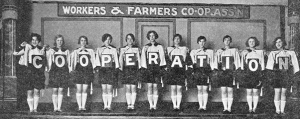 In many other ways, cooperatives have advantages over corporations as a more reliable system to dispense goods and services to consumers and customers. As an example, the following citation from Wikipedia explains how coops are typically established for social rather than economic benefit, but are still capable of profit so long as it does not become the prime motivation:
In many other ways, cooperatives have advantages over corporations as a more reliable system to dispense goods and services to consumers and customers. As an example, the following citation from Wikipedia explains how coops are typically established for social rather than economic benefit, but are still capable of profit so long as it does not become the prime motivation:
“Economic benefits are distributed proportionally to each member’s level of participation in the cooperative, for instance, by a dividend on sales or purchases, rather than according to capital invested. Cooperatives may be classified as either worker, consumer, producer, purchasing or housing cooperatives. They are distinguished from other forms of incorporation in that profit- making or economic stability are balanced by the interests of the community.”
Cooperatives are empowered to follow more sustainable practices of growth without risking failure because the profit incentive is balanced with the responsibilities to members and the community.
For more information, check out The Cooperative Development Foundation for their list of seven basic principles for cooperatives.
What is meant by sound monetary principles?
The concept of sound monetary principles stems from a need for people and  workers in all classes and walks of life to have a medium of exchange for the fruits of their labors. When that medium is centrally controlled and monopolized, as it is in the case of the U.S. Dollar, then it becomes a method of enslavement. Because of the blatant exploitation of debt based currency in the U.S. today, many regions, states and even towns are producing local alternative currencies to help protect people in the event of a Dollar collapse brought on by misuse and corruption in Government and corporate banking. The late philosopher Ludwig von Mises, was influential in Libertarian principles of economics; in 1912 he wrote,
workers in all classes and walks of life to have a medium of exchange for the fruits of their labors. When that medium is centrally controlled and monopolized, as it is in the case of the U.S. Dollar, then it becomes a method of enslavement. Because of the blatant exploitation of debt based currency in the U.S. today, many regions, states and even towns are producing local alternative currencies to help protect people in the event of a Dollar collapse brought on by misuse and corruption in Government and corporate banking. The late philosopher Ludwig von Mises, was influential in Libertarian principles of economics; in 1912 he wrote,
“The sound-money principle has two aspects. It is affirmative in approving the market’s choice of a commonly used medium of exchange. It is negative in obstructing the government’s propensity to meddle with the currency system.”
And further:
“It is impossible to grasp the meaning of the idea of sound money if one does not realize that it was devised as an instrument for the protection of civil liberties against despotic inroads on the part of governments. Ideologically it belongs in the same class with political constitutions and bills of right.”
Sound money is normally viewed as currency backed by a precious commodity such as Gold or Silver. But sound money can be backed by other means. The concept of “Natural Capital” can be viewed as a more sustainable way of backing alternative currencies that are springing forth throughout the country. From Wikipedia, Natural capital is described as,
the extension of the economic notion of capital (manufactured means of production) to goods and services relating to the natural environment. Natural capital is thus the stock of natural ecosystems that yields a flow of valuable ecosystem goods or services into the future. For example, a stock of trees or fish provides a flow of new trees or fish, a flow which can be indefinitely sustainable. Natural capital may also provide services like recycling wastes or water catchment and erosion control. Since the flow of services from ecosystems requires that they function as whole systems, the structure and diversity of the system are important components of natural capital.
Natural capital can also be seen to be a part of the labor provided by workers in services that are sustainable. When you connect these ideas together, it becomes easy to see that economic alternatives to debt based currencies exist and can be managed more sustainably for smaller economies that may be otherwise ravaged by rampant overprinting of currencies and debt practices.
This model of alternative banking is currently practiced by cooperatively owned banks or credit unions, but can be expanded into investment models where old Capital is exchanged for savings in newer “Natural Capital” forms of businesses. As pointed out earlier, coops are more than twice as likely to remain in business over longer periods of time and function well in crisis, so they become good “Havens” for savings. Many new cooperative businesses could be started rather inexpensively following preplanned models and Open-Source practices for technology and education. Investment could be provided to help springboard cooperative businesses into existence in many different areas and regions. Independently, these businesses will have a community of backers that will eventually work to pay back the invested funds through the services they provide but then take eventual ownership of the community business. Collectively, these businesses will be stronger because of the network of support from the investments and the open collaboration. The investors can receive their return on investment with usual interest and while their funds are invested, their savings are more safely vested in businesses centered on the involvement of natural capital and services to a community that is cooperatively involved.
Why open source for key technologies?
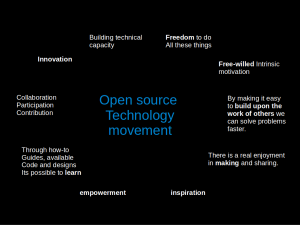 Open source is a method and means of distributing technology and services freely and collaboratively across a wide array of individuals and communities. According to Wikipedia;
Open source is a method and means of distributing technology and services freely and collaboratively across a wide array of individuals and communities. According to Wikipedia;
Open-source hardware is hardware whose initial specification, usually in a software format, are published and made available to the public, enabling anyone to copy, modify and redistribute the hardware and source code without paying royalties or fees. Open-source hardware [and software] evolves through community cooperation. These communities are composed of individual hardware/software developers, hobbyists, as well as very large companies.
Open source collaboration is utilized today for a variety of services and needs. Some of these include software such as applications and operating systems, hardware such as electronics and tools, healthcare and sciences, even recipes for foods and beverages. Open source is a growing and evolving tool for cooperative collaboration. Users are allowed access to the source information and can then utilize, adapt, modify, resell, or share however they like but may never own the original or source.
Open source works much like recipes for foods from similar restaurants, whereby deferent owners use different methods and ingredients for preparing the same dishes. For example, none of the business owners own the actual recipe for a particular dish but each have their own unique way of preparing it, making it uniquely theirs. Meanwhile, nothing is stopping anyone else from printing out the open source recipe for this dish and making it themselves. This is a simple analogy but goes a long way to describe how other tools for collaboration may be utilized in the same way to further open certain markets up to more dynamic competition. Open source is also a strong equalizer in markets that are otherwise monopolized by unfair business practices. Wikipedia also notes,
The rise of open-source culture in the 20th century resulted from a growing tension between creative practices that involve appropriation, and therefore require access to content that is often copyrighted, and increasingly restrictive intellectual property laws and policies governing access to copyrighted content… In the late 20th century, cultural practitioners began to adopt the intellectual property licensing techniques of free software and open-source software to make their work more freely available to others, including the Creative Commons… Essentially born out of a desire for increased general access to digital media, the Internet is open-source culture’s most valuable asset. It is questionable whether the goals of an open-source culture could be achieved without the Internet. The global network not only fosters an environment where culture can be generally accessible, but also allows for easy and inexpensive redistribution of culture back into various communities.
Famous macro economist, John Maynard Keynes once noted, “It is easier to ship recipes than cakes and biscuits.” This sentiment can be carried over to other systems and models for business development. The open source community or culture seeks to remove barriers to success by sharing and cultivating ideas and techniques. The “End Products” from such collaboration can still be used and sold as if they were manufactured by any other organization or company. Much the same way you can have many different restaurants with similar menus but each produces their own unique variation of well known dishes and each operates under it’s own business practices. The same tools could be used for computer businesses, broadband and internet providers, basic manufacturing and tooling, construction practices, healthcare, education and training, management principles, agriculture and food processing, and much, much more. The end goal of open source collaboration is to promote strength in numbers while also balancing markets with viable competition that grows organically from consumer needs. When coupled with cooperative business practices, many different groups of cooperatives can band together and collaborate on products and services through open source culture to maintain high levels of quality and performance while competing with larger more established corporations that monopolize markets. When the right tools are utilized for individual businesses to band together, their limitations are minimal and their successes multiply.
This category of posts will continue to develop and grow. The Cooperative and Open Source cultures are expanding everyday as new tools and ideas are developed to counteract the centralization of control over key areas of services and products. It is my hope to provide several examples over time that demonstrate that top down hierarchal dominance structures are eroding and being replaced for more decentralized and cooperative solutions.
-Quixotic


